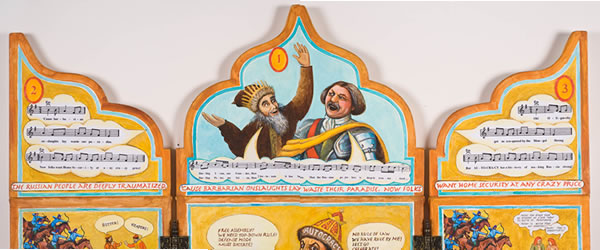Because I seem to be the first
non-UT/DWRL blogger on viz., I’ll introduce myself. I’m Anne Bobroff-Hajal. I'm an artist
interested in something rather hard to find: fine art that incorporates
clearly-graspable rhetoric. Art that attempts to integrate the left
brain with the right.

Detail of Home Security at Any
Crazy Price
So my entries on this blog will
be a treasure hunt, searching for artists who have a double goal: to
communicate something rational or scientific about the real world in a way that
also powerfully moves and/or delights us. There aren’t many such
artists. John Jones accurately observed that visual argument tends, “contrary to Aristotle’s advice,
[to] foreground the use of pathos and ethos rather than logos.” I’m
searching for those very rare artists from whom I – and maybe others – can
learn techniques to balance logos, pathos, and ethos.
I’ll look for lessons we can
learn about how to convey sophisticated, logical ideas on any subject: society,
science, current events, history, the environment, whatever. I’m not
looking for propaganda, though, except in cases where its artistic content is
very high.
Much “political” art today is
actually at the other extreme from propaganda. It may be beautiful to
look at, but its rhetorical content can’t be discerned without reading a
lengthy accompanying artist’s statement. I’d like to find visual
art that falls between those extremes: art that makes its rhetoric evident via
visual means that are also beautiful, or wondrous, or touch us deeply.
I won’t debate the points of
view the artists portray, but rather look for the lessons we can learn from
each about how to make an argument visually. I celebrate the skills of artists
who move their audience to debate.
Readers’ own finds would be most
welcome additions to this treasure hunt. Please post them in the comments
section.
By the way, my interest in this
search began after I began Playground of the Autocrats, a series of mixed media
triptychs that convey my theories about Russian history (which I consider
relevant to our lives today), developed during my Ph. D. studies in Russian
history at the University of Michigan. I wasn’t sure for a while whether
Playground of the Autocrats could be considered art. So I hoped to find other artists who had
successfully achieved what I was attempting.

Recent comments
2 years 29 weeks ago
2 years 44 weeks ago
2 years 44 weeks ago
2 years 50 weeks ago
3 years 4 weeks ago
3 years 4 weeks ago
3 years 4 weeks ago
3 years 6 weeks ago
3 years 6 weeks ago
3 years 6 weeks ago